|
|
|
|
|
|
|
|
|
|
|
|
Seoul (3)South Korea - Asia

Yeouido Island, Seoul, at dawn. As a Special City, it is administered directly by the national government. With over ten million people, Seoul is South Korea's largest city and one of the most populous cities in the world. The city is located on the basin of the Han River in the country's northwest. The North Korean border is about 50 km to the north. The Seoul National Capital Area - which includes the major port city of Incheon and many satellite towns in Gyeonggi-do - has almost 23 million inhabitants, making it the second most populous metropolitan area in the world. Almost half of South Korea's population lives in the Seoul National Capital Area, and nearly one quarter in Seoul itself, making it the country's political, cultural, and economic centre. Incheon International Airport and Gimpo International Airport are linked to Seoul by highways, and Gimpo is also linked by subway (line #5). The Incheon International Airport Railroad, a rail line connecting Incheon Airport to Gimpo Airport opened in March 2007, but the line to Seoul Station in central Seoul will take at least a year more to open. Shuttle buses transfer passengers between Incheon and Gimpo airports.
AREX 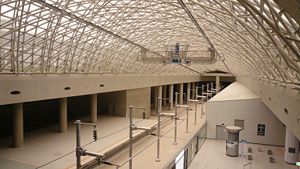
View of the station at Incheon International Airport. The line is operated by the Airport Railroad Co. Ltd., whose largest shareholders are Hyundai (27%), Daelim (18%) and POSCO (12%); it is fully privatised. History After significant delays, construction of the line started in 2002. The first 37.6 km segment from Incheon Airport to Gimpo opened on March 23, 2007, with the remaining length of 20.4 km to Seoul Station scheduled to be operational in January 2010. The line is being constructed by IKFC (Incheon Korean French Consortium), a consortium headed by Eukorail. Eukorail includes as partners the French company Alstom and the South Korean company ROTEM, and also built the KTX high-speed train line. 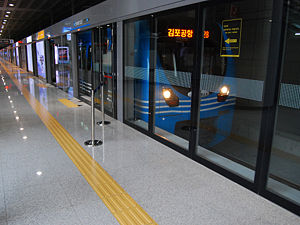
A train at Incheon International Airport Station Services Both express and commuter services are operated. Journeys from Incheon to Gimpo presently take 28/33 minutes on express and commuter services respectively. When the full line opens, Express services will operate with 30-to-60 minute headways, taking 45 minutes to the city, while commuter services will operate at 5-to-30 minute intervals, taking 53 minutes. The trains have a design speed of 120 km/h. Express trains have overhead shelves and comfortable seats similar to those in KTX high-speed trains. Commuter trains are similar to subway trains and do not have overhead shelves. 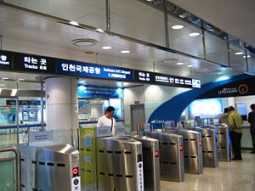
AREX train running between Incheon and Gimpo Airport.
All text is available under the terms of the GNU Free Documentation License (see Copyrights for details). About Wikipedia Disclaimers
Seoul Buses 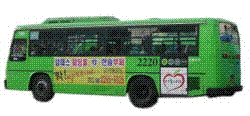
Seoul Branch Bus (Green) There are four types of buses: Trunk Bus (Blue): This type of buses will operate at higher speeds and access the median bus lane connecting suburban areas to downtown Seoul. The city government is partly in charge of its operation. The city has taken full consideration to introduce 3 kinds of buses belonging to the Blue Bus category: bendable bus, CNG (compressed natural gas) bus with a lower platform, and regular large-sized CNG bus. The blue color represents Seoul's skyline and Hangang (River) to symbolize security and freedom. Branch Bus (Green): Green bus will be flexibly operated by private bus companies, to connect major subway stations or bus terminals in downtown Seoul. It is similar with the city bus and the community shuttle bus currently in operation. Green stands for the mountains surrounding the city. Rapid Bus (Red): The red buses will be express buses designed specially for those commuting between downtown Seoul and the metropolitan area. The color red exudes energy of speed. Circulation Bus (Yellow): This bus will circle downtown Seoul and stop at stations for blue buses and major railway stations, as well as business, tourist and shopping areas. Yellow was selected for its dynamic and friendly image. Route numbers specify area divisions. For Trunk and Branch Bus, the first digit indicates the area where the route begins, and the second digit indicates where the route ends. For Rapid Bus, the first digit is always 9, and the second indicates the area in which the route begins. The first digit of Circulation Bus indicates the area in which the bus circles. Route number which start with 8 indicates holiday/rush-hour only branch buses. For all lines, any remaining numbers are individual routes. Bus area With the improvement of its public transportation system, Seoul introduced new bus numbering system, including area numbers in order to facilitate recognition of route outlines.
Fares The system uses cash or Transportation Cards. Rates vary depending on which route is taken. 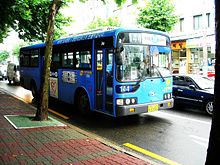
Yeouido Island, Seoul, at dawn. Most buses in South Korea are domestic models and made by two manufacturers. Buses use either diesel or compressed natural gas. A list of buses used in Seoul:
All text is available under the terms of the GNU Free Documentation License (see Copyrights for details). About Wikipedia Disclaimers
2007
Seoul Metropolitan Subway
Locale: Seoul, South Korea Incheon, Gyeonggi-do, Chungcheongnam-do Transit type: Rapid transit Began operation: 1974 System length: 287 km (179.4 mi) No. of lines: 10 No. of stations: 266 Track gauge: 1,435 mm (4 ft 8½ in) Owner: Seoul Metropolitan City Government, Korea Rail Network Authority Operator: Seoul Metro, Korail, SMRT 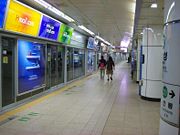
A Seoul Metro Station. The system serves Seoul, Incheon, Gyeonggi province and northern Chungnam province and connects with the single-line Incheon Subway system. There is a connection (not a free transfer) to the Incheon International Airport Railroad (A'REX) at Gimpo Airport Station on Line 5. Over 70% of the total metro track length is underground. The Seoul Subway is considered user friendly for non-Koreans since all directional signs are written in both Korean and English, and the voice announcement in the trains indicating the upcoming station, possible line transfer and exiting side are all said in Korean, followed by English. However Line 2 (Green Line) has additional side lines and at times passengers will be told to exit the train and board the following train instead. These broadcasts are in Korean only and therefore do lead to confusion for foreign travelers. 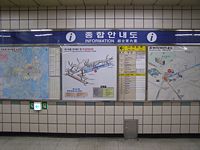
A Seoul Metro Station Maps. The subway is operated by three different organisations: Korail; Bundang Line, Jungang Line, most of Line 1, and parts of Lines 3 & 4. An average of 2,177,000 people use Korail's Seoul commuter lines daily. Seoul Metro; Line 2, underground section of Line 1, and large parts of Lines 3 & 4. The corporation runs a total of 199 trains at 115 stations on lines 1-4. Generally, operation intervals are 2.5 -3 minutes during rush hours and 4-6 minutes during non-rush hours. An average of 3,879,000 passengers use subway lines 1-4 daily. Seoul Metropolitan Rapid Transit Corporation; (SMRT) Lines 5, 6, 7, and 8. An average of 2,037,000 passengers use subway lines 5-8 daily. The operators for lines currently under construction are as follows: Seoul Metro Line 9 Corporation for Line 9 Shin Bundang Line Corporation for the New Bundang Line Yongin Light Rail Corporation for the EverLine Rapid Transit System Lines The subway lines and their operators and colours are as follows:
History The Korail, the forerunner of the Seoul Metro, began operating Line 1 in 1974. Lines 2, 3, and 4 followed in the late 1970s and 1980s. The SMRT was formed in 1994 to take over operation of lines 5 to 8.
All text is available under the terms of the GNU Free Documentation License (see Copyrights for details). About Wikipedia Disclaimers
2007
Site Index Back to Top Photos Index Thanks for coming, I hope you
have enjoyed it, will recommend
it to your friends, and will come
back later to see my site developing
and expanding.
|